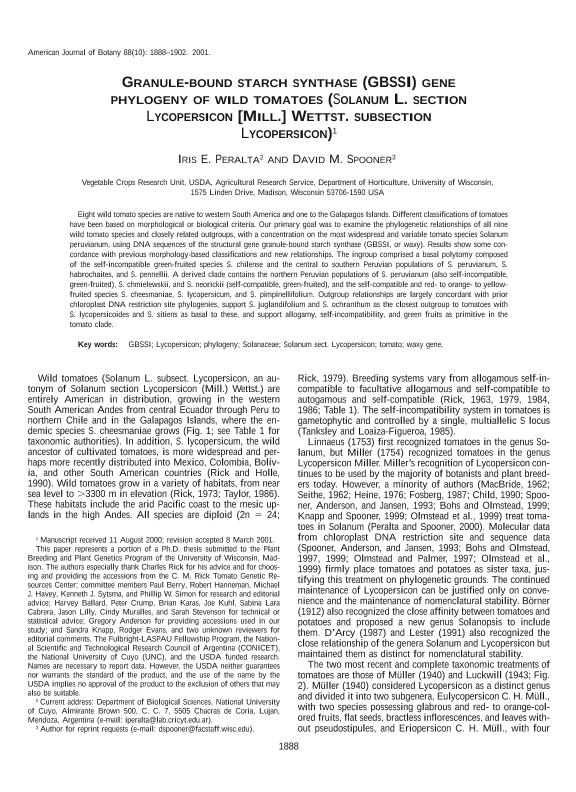Artículo
Granule-bound starch synthase (GBSSI) gene phylogeny of wild tomatoes (Solanum L. section Lycopersicon [Mill.] Wettst. subsection Lycopersicon)
Fecha de publicación:
03/2001
Editorial:
Botanical Society of America
Revista:
American Journal of Botany
ISSN:
0002-9122
Idioma:
Inglés
Tipo de recurso:
Artículo publicado
Clasificación temática:
Resumen
Eight wild tomato species are native to western South America and one to the Galapagos Islands. Different classifications of tomatoes have been based on morphological or biological criteria. Our primary goal was to examine the phylogenetic relationships of all nine wild tomato species and closely related outgroups, with a concentration on the most widespread and variable tomato species Solanum peruvianum, using DNA sequences of the structural gene granule-bound starch synthase (GBSSI, or waxy). Results show some concordance with previous morphology-based classifications and new relationships. The ingroup comprised a basal polytomy composed of the self-incompatible green-fruited species S. chilense and the central to southern Peruvian populations of S. peruvianum, S. habrochaites, and S. pennellii. A derived clade contains the northern Peruvian populations of S. peruvianum (also self-incompatible, green-fruited), S. chmielewskii, and S. neorickii (self-compatible, green-fruited), and the self-compatible and red- to orange- to yellow-fruited species S. cheesmaniae, S. lycopersicum, and S. pimpinellifolium. Outgroup relationships are largely concordant with prior chloroplast DNA restriction site phylogenies, support S. juglandifolium and S. ochranthumn as the closest outgroup to tomatoes with S. lycapersicoides and S. sitiens as basal to these, and support allogamy, self-incompatibility, and green fruits as primitive in the tomato clade.
Archivos asociados
Licencia
Identificadores
Colecciones
Articulos(IADIZA)
Articulos de INST. ARG DE INVEST. DE LAS ZONAS ARIDAS
Articulos de INST. ARG DE INVEST. DE LAS ZONAS ARIDAS
Citación
Peralta, Iris Edith; Spooner, David M.; Granule-bound starch synthase (GBSSI) gene phylogeny of wild tomatoes (Solanum L. section Lycopersicon [Mill.] Wettst. subsection Lycopersicon); Botanical Society of America; American Journal of Botany; 88; 1-12; 3-2001; 1888-1902
Compartir
Altmétricas




